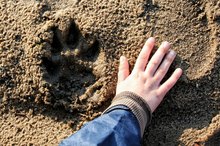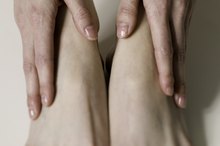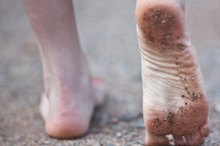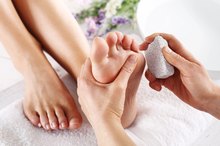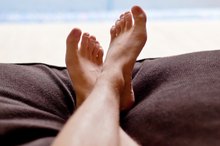What Causes Peeling Skin on Children's Feet?
If a child's feet are peeling, the cause is usually not serious. Skin dryness or damage, athlete’s foot, or skin conditions such as eczema or psoriasis are the most common causes of this symptom, which may be associated with redness, itching, pain or oozing. While home care is often a first step in management, in certain cases, peeling feet may require an evaluation by a pediatrician or dermatologist.
Dry or Damaged Skin
Skin naturally goes through a growth cycle, which ends with the sloughing off of dead skin. If feet don’t get scrubbed and washed regularly, this dead skin can become noticeable, and may flake off and peel. Flaky skin may also be a consequence of dehydration, due to exposure to dry air, or related to skin damage. For example, feet that have suffered sunburn will peel as the damaged skin heals. Also, friction blisters can be caused by ongoing rubbing or pressure due to tight or poor fitting shoes, and as these heal, the blistered skin eventually peels away.
- Skin naturally goes through a growth cycle, which ends with the sloughing off of dead skin.
- Also, friction blisters can be caused by ongoing rubbing or pressure due to tight or poor fitting shoes, and as these heal, the blistered skin eventually peels away.
Athlete's Foot
The Skin on My Child's Hands Is Peeling
Learn More
Another common cause of skin peeling is Athlete's foot, a fungal infection that develops in moist areas -- most commonly between the toes, but sometimes on other parts of the foot 1. If feet spend too much time in damp, sweaty socks or shoes, this infection can develop. Athlete's foot may also cause pain, blisters and cracks in the skin which can be an entry point for infections. Treatment involves the application of over-the-counter antifungal cream, and keeping the feet dry. Sometimes prescription medications are needed.
- Another common cause of skin peeling is Athlete's foot.
- Treatment involves the application of over-the-counter antifungal cream, and keeping the feet dry.
Skin Conditions
Skin peeling can also occur due to certain skin conditions. Eczema, which also called dermatitis, is an inflammation of the skin that can lead to redness, itching, swelling, oozing, crusting and scaling -- which is characterized by the loss of large scale-like flakes of skin. Eczema is caused by an overactive immune system, but these skin symptoms can also be triggered by irritants, allergens or severely dry skin. Psoriasis, another autoimmune disorder, may also affect the feet. This condition is characterized by inflammation, and thick red, white or silvery patches of skin which flake. Itchy skin may occur, but burning or stinging sensations are more common. Common strategies to manage these conditions includes the removal of known triggers, and the use of topical ointments and medications.
- Skin peeling can also occur due to certain skin conditions.
- Itchy skin may occur, but burning or stinging sensations are more common.
Warnings
Itchy Feet While Exercising
Learn More
If your child’s feet are peeling, the cause is usually treatable and not serious. Peeling skin from dryness, sunburn, blisters or athlete's foot can usually be managed at home. However, if the peeling is a new symptom, and if accompanied by redness, swelling, fever, drainage or discomfort, seek an evaluation by your child’s pediatrician. Sometimes, peeling skin may be a drug side effect, and rarely, peeling skin on the toes or feet is a sign of a serious medical disorder, so if the recommended treatment plan does not improve symptoms, tell your child’s pediatrician.
Reviewed by Kay Peck, MPH RD
- If your child’s feet are peeling, the cause is usually treatable and not serious.
- Sometimes, peeling skin may be a drug side effect so if the recommended treatment plan does not improve symptoms, tell your child’s pediatrician.
Related Articles
References
- Merck Manual: Tinea Pedis
- American Academy of Family Physicians: Acne | Isotretinoin
- Merck Manual: Hand and Foot Dermatitis
- American Academy of Dermatology: Caring for a Child with Eczema
- Institute For Preventive Foot Health. National Foot Health Assessment 2012. 2012.
- Boutrand LB, Thépot A, Muther C, et al. Repeated short climatic change affects the epidermal differentiation program and leads to matrix remodeling in a human organotypic skin model. Clin Cosmet Investig Dermatol. 2017;10:43-50. doi:10.2147/CCID.S120800
- Kapur S, Watson W, Carr S. Atopic dermatitis. Allergy Asthma Clin Immunol. 2018;14(Suppl 2):52. doi:10.1186/s13223-018-0281-6
- Safer JD. Thyroid hormone action on skin. Dermatoendocrinol. 2011;3(3):211-215. doi:10.4161/derm.3.3.17027
- Hashizume H. Skin aging and dry skin. J Dermatol. 2004;31(8):603-609. doi:10.1111/j.1346-8138.2004.tb00565.x
- Parker J, Scharfbillig R, Jones S. Moisturisers for the treatment of foot xerosis: a systematic review. J Foot Ankle Res. 2017;10:9. doi:10.1186/s13047-017-0190-9
- Linus Pauling Institute. (2012-2016). Oregon State University: Micronutrient Information Center: Essential Fatty Acids and Skin Health.
Resources
Writer Bio
Lindsay Tadlock began writing in 2010. She has worked as a personal trainer for over three years and shares her fitness and nutrition knowledge in her writings. She graduated from Texas A&M University in 2000 with her Bachelor of Arts in finance and worked for seven years as a commercial lender.
